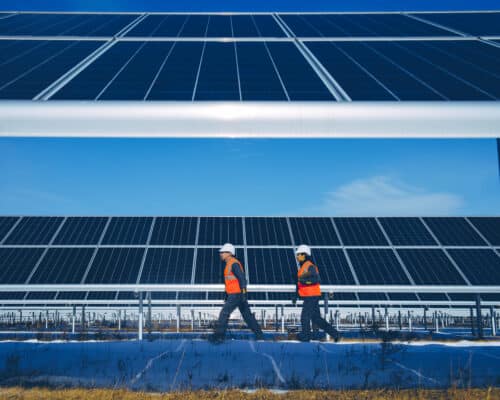Japan-Vietnam Energy Relations: Opportunities and Risks
Photo by Ilona Bradacova / Shutterstock.com
06 April 2023 – by Viktor Tachev Comments (0)
Japan and Vietnam have deep business ties. However, their relationship is now extending beyond economic cooperation: energy cooperation. While Vietnam has much to gain from this extensive strategic partnership, there is also the risk of inheriting the deficiencies of Japan’s decarbonisation strategy through its pursuit of natural gas, ammonia co-firing and hydrogen instead of renewable energy – a segment in which Vietnam has shown tremendous success.
The Focus Areas of Vietnam-Japan Relations
Over the years, the Japanese government has provided Vietnam with financial and technical assistance for its decarbonisation through programs like AETI.
The latest initiative was Phase VIII of the Vietnam-Japan Joint Initiative (VJJI), which started in 2003 and concluded in March 2023. Among its key focus areas was the promotion of green growth.
The program aimed to enhance cooperation between Japan and Vietnam in several key energy transition areas, including:
- clean energy development through offshore wind, solar and biomass,
- fuel conversion and environmental treatment for thermal power plants and turbines while in operation,
- expanding existing and developing new hydropower plants,
- providing solutions to improve energy efficiency and energy-saving capacity,
- the research and transfer of new technologies (energy and carbon storage and others),
- developing new transmission grids and modernising existing ones (with a focus on smart grids),
- building gas and LNG thermal power projects and
- the production and application of new energy sources, such as hydrogen and ammonia.
Vietnam’s Need For Energy Investment and Regulatory Changes
The new developments around the VJJI are crucial for Vietnam. According to McKinsey, the country would require USD 30 billion (10% of its current GDP) of annual investment to meet its 2050 net-zero goal. Foreign funding is mostly lacking, with 58% of green energy projects developed by local companies.
Vietnam must focus on reshaping its regulatory landscape, including the PPA structure, to attract much-needed foreign investment. In its current form, it limits clean energy developers.
While the government is already working to address this, there is room for improvement. For example, while the recently agreed upon Just Energy Transition Partnership for Vietnam is a step in the right direction, analysts warn that it remains more of a “black box” rather than a transparent investment framework.
Green Growth or Greenwash?
Vietnam is home to the operations of many Western tech giants and continues to attract some of the biggest foreign companies. As a result, the country’s electricity demand is estimated to grow significantly in the following years. The question now is how the country will satisfy this.
Vietnam looks towards Japan for support. Both countries have been partnering on national and corporate levels for decades. Meanwhile, Japan has recently started new campaigns as part of the VJJI initiative to increase investor confidence in Vietnam. The initiative notes that Japanese businesses can propose Vietnam’s policy development in areas such as green technology.
Furthermore, Vietnam’s leadership seems willing to embrace this opportunity. The country’s deputy prime minister recently turned to Toyota for technical support to help the country’s digital transformation and sustainable energy transition to achieve its net-zero goal. However, in the global automotive industry, Toyota is among the worst performers regarding decarbonisation progress. The company also has a history of actively advocating for delaying EV adoption in Japan and abroad.
Japan’s Shaky Climate Credentials
Japan will host this year’s G7 meeting. The country has already started showing leadership, including inviting guest countries from the “Global South” (Vietnam included) to the talks. The Japanese leadership has singled out climate change as one of the conference’s main topics.
However, the country has lagged far behind the other G7 nations regarding decarbonisation policies and clean energy adoption. Japan has been the last to act on ending overseas coal financing, and according to Fossil Free Japan, it remains the world’s largest provider of public fossil fuel finance.
It was also widely criticised by other G7 members for its hesitance to stop the purchasing of Russian fossil fuels. The bloc also opposed Japan’s proposal to use its presidency to advocate for natural gas investment and the deployment of technologies to support using fossil fuels for power generation.
The Risks For Vietnam
Japan has pledged financial and technological support to help ASEAN countries accelerate their decarbonisation efforts and combat climate change. However, renewable power aside, this support will also go towards natural gas, hydrogen and ammonia.
While it remains unclear how this cooperation with Japan will affect Vietnam, the risk of Japan projecting the deficiencies of its clean technology strategy on Vietnam’s energy policy is genuine. For example, Vietnam recently signed up for Japan’s Asia Zero Emission Community (AZEC) scheme. The mechanism aims to achieve carbon neutrality by prioritising natural gas, hydrogen and ammonia. Such a move poses various risks to recipient countries.
Japan has long been known for its obsession with fossil fuels, including building new capacity or exploring questionable and expensive technologies to extend the lives of its coal plants.
The lack of clarity regarding Vietnam’s JETP structure also surfaces the risk of the country channelling funds into technologies with little-to-no decarbonisation credentials when it has already used extensive efforts to build clean energy capacity at scale.
Japan’s Role in Progressing the Energy Transition in Vietnam
Vietnam has the best clean energy potential in Southeast Asia and a remarkable track record in taking advantage of it. If the country doesn’t proceed with building on its existing platform and ends up pursuing distracting technologies, it will have only itself to blame.
The World Bank ranks Vietnam among the five countries most likely to be affected by climate change. Ho Chi Minh, responsible for 23% of the country’s GDP, is among the most vulnerable cities to rising sea levels globally. Climate change-related costs already trimmed Vietnam’s GDP by 3.2% in 2020. By 2050, the World Bank sees a GDP drop of 12% to 14.5%.
At the same time, Vietnam is massively reliant on coal, and its emissions are rising. It needs to phase coal out, not extend its life, to escape this perilous situation.
The partnership with Japan can unfold in two ways. It could be a beneficial relationship for both Vietnam and its climate goals. Or, Japan could lead the country down an unfortunate path, causing it to invest in distracting technologies. Fortunately, Japan has all the tools, expertise and resources to influence the country in a positive way.
by Viktor Tachev
Viktor has years of experience in financial markets and energy finance, working as a marketing consultant and content creator for leading institutions, NGOs, and tech startups. He is a regular contributor to knowledge hubs and magazines, tackling the latest trends in sustainability and green energy.
Read more




